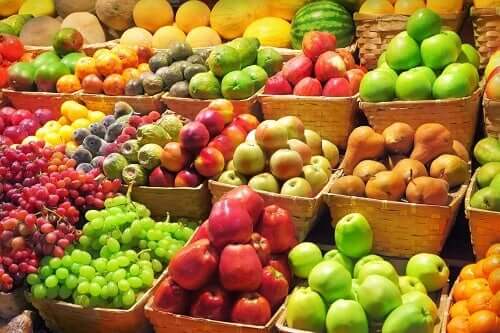Why it's Important to Eat Fruit and Vegetables According to WHO


Written and verified by the nutritionist Minerva Camero Albella
The World Health Organization (WHO) often tells us what we should eat in order to be healthy. In this article, you’ll learn everything WHO says about why it’s important to eat fruit and vegetables.
And, as you already know, eating a suitable amount of vegetables is one of the eating habits associated with a better state of well-being. It can also help to prevent certain illnesses!
The numbers speak for themselves
According to WHO reports, 1.7 million lives could be saved worldwide just by increasing the amount of fruit and vegetables we eat. It turns out that just by consuming an average of 14 ounces of these in our daily diet, we can prevent chronic health problems like diabetes and cardiac illnesses.
In a similar vein, WHO calculates that diets boasting an insufficient amount of fruit and vegetables cause approximately 19% of gastrointestinal cancers, 30% of ischemic heart disease, and 11% of strokes across the globe. This is evidenced in an investigation published in the International Journal of Epidemiology.

You may also be interested in: 7 Fruits and Vegetables that May Help Reduce the Risk of Cancer
Is it fashionable to eat fruit and vegetables?
Although it’s true that the number of people opting for a diet rich in fruit and vegetables has increased recently, it goes beyond a trend.
More people are choosing to follow a vegetarian or vegan diet, some possibly because it’s fashionable and others for diverse factors, from religious reasons to respect for the animals. However, it’s very important to know how to transition to this lifestyle.
Fashionable or not, fruit and vegetables are necessary to maintain good health and prevent illnesses. The combination of these foods with others that form part of a balanced diet will guarantee a good supply of all the essential nutrients.
Daily fruits and vegetables
The World Health Organization (WHO) tells us the following:
- Eat at least 14 ounces or five portions of fruit and vegetables a day
- Include vegetables at every meal
- Prepare snacks with fresh fruit and raw vegetables
- It’s best to eat seasonal fruit and vegetables
- Eat a varied selection

Similarly, on a global level, there’s the 5-a-day organization. They promote information that helps people to meet these recommendations, and they even adjust it for each country!
A ration is the equivalent of:
- Vegetables and greens (4.90 to 5.30 ounces raw and clean). They also highlight that you should eat 2 rations a day.
- Fruit (4.90 to 5.30 ounces raw and clean). It’s best to consume 3 rations a day.
Don’t leave without reading: 10 Best Fruits for Fighting Against Water Retention
There are no limits when it comes to the maximum amount you can eat, the type of fruit or vegetable, or the preparation method you use. Among the recommendations, they suggest having a variety of fruit and vegetables, with a preference for seasonal products for their freshness and better price.
If there’s a fruit or vegetable that you don’t get on with, you’re not obliged to eat it. You just need to select the ones that you do like to eat and distribute them throughout the day.
Eat fruit regularly
As you can see, eating fruit and vegetables is essential to guarantee a good state of health. For this reason, you should try to include these foods in your diet every day, with the objective being to delay aging and the development of complex illnesses.
If you don’t like the taste, try to combine them with other foods and introduce them into your diet progressively. There are many recipes that manage to disguise the texture and taste of vegetables, made especially for people that aren’t used to eating them.
As a final note, remember that you can always visit a nutritionist in case you need your current diet evaluated or the creation of a healthier menu.
All cited sources were thoroughly reviewed by our team to ensure their quality, reliability, currency, and validity. The bibliography of this article was considered reliable and of academic or scientific accuracy.
- Agencia de Salud Pública de Cataluña. (2019). Pequeños cambios para comer mejor. https://salutpublica.gencat.cat/web/.content/minisite/aspcat/promocio_salut/alimentacio_saludable/02Publicacions/pub_alim_salu_tothom/Petits-canvis/La-guia-peq-cambios-castella.pdf
- Aune, D., Giovannucci, E., Boffetta, P., Fadnes, L. T., Keum, N., Norat, T., Greenwood, D. C., Riboli, E., Vatten, L. J., & Tonstad, S. (2017). Fruit and vegetable intake and the risk of cardiovascular disease, total cancer and all-cause mortality—a systematic review and dose-response meta-analysis of prospective studies. International Journal of Epidemiology, 46(3), 1029-1056. https://doi.org/10.1093/ije/dyw319
- Bertoia, M. L., Mukamal, K. J., Cahill, L. E., Hou, T., Ludwig, D. S., Mozaffarian, D., Willett, W. C., Hu, F. B., & Rimm, E. B. (2015). Changes in Intake of Fruits and Vegetables and Weight Change in United States Men and Women Followed for Up to 24 Years: Analysis from Three Prospective Cohort Studies. PLOS Medicine, 12(9), e1001878. https://doi.org/10.1371/journal.pmed.1001878
- Fruit and vegetables. (s. f.). Better Health Channel. https://www.betterhealth.vic.gov.au/health/healthyliving/fruit-and-vegetables
- Fruit and Vegetables. (s. f.). Food and Agriculture Organization of the United Nations (FAO). https://www.fao.org/3/cb2395en/online/src/html/fruit-and-vegetables.html
- Fruit and vegetable intake. (s. f.). World Health Organization (WHO). https://www.who.int/data/gho/indicator-metadata-registry/imr-details/3417
- Healthy diet. (2020). Word Health Organization (WHO). https://www.who.int/news-room/fact-sheets/detail/healthy-diet
- Miller, V. A., Mente, A., Dehghan, M., Rangarajan, S., Zhang, X., Swaminathan, S., Dagenais, G. R., Gupta, R., Mohan, V., Lear, S. A., Bangdiwala, S. I., Schutte, A. E., Wentzel-Viljoen, E., Avezum, A., Altuntas, Y., Yusoff, K., Ismail, N. H., Peer, N., Chifamba, J., . . . Wen-Hua, Z. (2017). Fruit, vegetable, and legume intake, and cardiovascular disease and deaths in 18 countries (PURE): a prospective cohort study. The Lancet, 390(10107), 2037-2049. https://doi.org/10.1016/s0140-6736(17)32253-5
- Phytonutrients – Nature’s Natural Defense. (s. f.). Unlock Food. https://www.unlockfood.ca/en/Articles/Vitamins-and-Minerals/Phytonutrients-%E2%80%93-Nature%E2%80%99s-Natural-Defense.aspx
- U. S. Department of Agriculture and U. S. Department of Health and Human Services. (2020). Dietary Guidelines for Americans 2020-2025. https://www.dietaryguidelines.gov/sites/default/files/2021-03/Dietary_Guidelines_for_Americans-2020-2025.pdf
- Vegetables and Fruits. (2021, 3 marzo). The Nutrition Source. https://www.hsph.harvard.edu/nutritionsource/what-should-you-eat/vegetables-and-fruits/
- Wang, P., Fang, J., Gao, Z., Zhang, C., & Xie, S. (2015). Higher intake of fruits, vegetables or their fiber reduces the risk of type 2 diabetes: A meta‐analysis. Journal of Diabetes Investigation, 7(1), 56-69. https://doi.org/10.1111/jdi.12376
- Zurbau, A., Au-Yeung, F., Mejia, S. B., Khan, T., Vuksan, V., Jovanovski, E., Raz, I., Kendall, C. W., Jenkins, D. J., & Sievenpiper, J. L. (2020). Relation of Different Fruit and Vegetable Sources With Incident Cardiovascular Outcomes: A Systematic Review and Meta‐Analysis of Prospective Cohort Studies. Journal of the American Heart Association, 9(19). https://doi.org/10.1161/jaha.120.017728
This text is provided for informational purposes only and does not replace consultation with a professional. If in doubt, consult your specialist.








